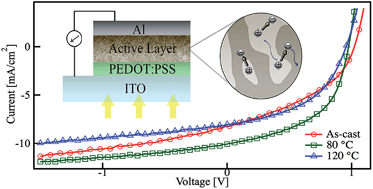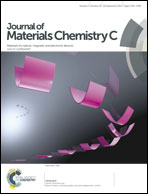Effect of thermal annealing on active layer morphology and performance for small molecule bulk heterojunction organic solar cells†
Abstract
New molecule design and device optimization are two of the main strategies used to obtain high performance organic photovoltaics. In this paper, bulk heterojunction solar cell devices using a newly designed solution-processable small molecule (DRDTSBDTT) were systematically investigated for their J–V behavior and the morphology of the active layer under different annealing treatments to understand the impact of thermal annealing on open circuit voltage, short circuit current and fill factor. A strong relationship was found between thermal annealing and these factors. J–V behavior analysis indicates that this is because of the efficiency change of the fundamental exciton diffusion, charge separation and collection steps, which is supported by morphology studies for the active layer under different thermal treatments. The results show that for optimized performance of a given molecule, the morphology and phase control are the most important factors to achieve intrinsic best performance. With these, the power conversion efficiency was increased from 3.36% to 5.05% under optimized annealing treatment for DRDTSBDTT-based devices.



 Please wait while we load your content...
Please wait while we load your content...